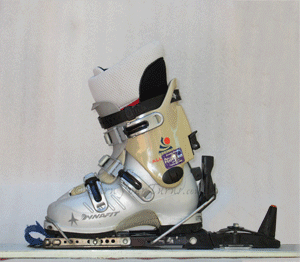
Some things still haven’t been duplicated. Like the Ramer climbing post. None go higher, none equal it’s low setting either. But why would you use a Ramer binding with a Dynafit boot?
Last week I was struck by the hole that exists in the AT world these days for a binding that works with tech-less alpine boots and weighs less than four pounds. It simply doesn’t exist anymore. Not in retail stores anyway. But if you sleuth enough, you can find an old pair of Ramer Classics that could, if you’re willing to believe, and willing to compromise on safety, fit the bill.
Er, how much of a compromise you say? That depends on your skiing style. Some guys could never feel solid in Ramers, others had few complaints. The same quandry exists today with Tech bindings, only now we know that the problem isn’t the hardware, it’s the software between the users ears that refuses to believe, and a little thing called faith.
The Ramer/Low Tech Connection
No one believed that Dynafit was strong enough or safe enough when first introduced but the same people who were attracted to the Ramer for its simplicity and light weight functionality were equally attracted to Dynafit. With millions upon millions of vertical feet logged over two decades the evidence can’t be denied; you can believe me now or later, but the ball and socket concept works. The original incarnation of that, the Ramer Classic, worked too, and still does if you can find a pair. When Fritz Barthel turned the Ramer concept inside out and eliminated the plate by using the boot as an integral part of the binding, the Ramer was doomed simply because of the savings in weight. That and the inability to incorporate ski brakes with the binding.
Classic Mechanics
Over the years Paul Ramer was able to trim his Classic binding to under 3 pounds, but if you manage to obtain one who knows what version it will be. Some of the ways the heel lever is adjusted for your boot size may change, but the main components of a pair of spring bars protruding from a boot plate clamped to an axle were the essence of the Ramer design. The axle at the toe had two hemispherical ends that the spring bars clamped to, yielding both a touring pivot and a release mechanism, an ingenious design. The clamping force doubled as the release threshold and is determined by how far away from the axle a bolt holds the spring-bars tight. The further away it is, the easier the bars can be twisted off the axle. Ramer claimed his binding had DIN calibrated release, but that was never really true. It had an adjustable release tension that was not certified in a lab, but it did work in the field. Its weakness was it lacked much of a return to center force. With sufficiently high tension it could hold while bashing bumps or while skinning an icy traverse, but if you set the tension below level 7 it released easily on a traverse, or unexpectedly while skiing. If you are comfortable with a high release tension, it works admirably.
The death knell for Ramer wasn’t the release mechanism, but rather the inability to offer ski brakes. If you did release from the binding, a leash was required. A simple webbing strap would work, and Ramer did offer a strap that, theoretically, would release in an avalanche. Outside of an avalanche though, few skiers are willing to risk getting bludgeoned by their own skis if they’re windmilling after a fall.
The Climbing Peg – a Ramer first!
To this day it is still my favorite climbing peg for the various heights it allowed – flat, mellow, high, and what Paul called the Super Climber. This was an add-on post that could be stacked to make even 35° skin tracks feel flat underfoot, provided, of course, you could get your skins to hold on snow that steep. After learning the benefits of a mellow angled skin track the lowest peg became my fave, which offers a mere 3° of inclination, perfect for flattening out a moderate skin track without compromising edging on a traverse.
Mechanical Aptitude Required
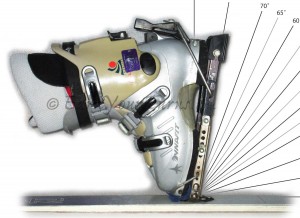
Excellent touring ROM but it did require a bit of maintenance. Ramer recommended applying a special red grease to keep the pivot lubed to prevent wear and improve reliability for release.
For instance, when the binding released, you had to know how to get the binding back on, which required a bit of know how and strength, especially if you had a high release value dialed in. To reattach, you cocked the binding back on to the axle. A simple procedure when you know, an impossible one if you don’t.
Conclusion
For those who don’t have or aren’t ready to buy new boots with tech inserts, but you want simplicity, basic functionality, and light weight, the Ramer Classic AT binding is still the next best thing (if you can find a pair).© 2012


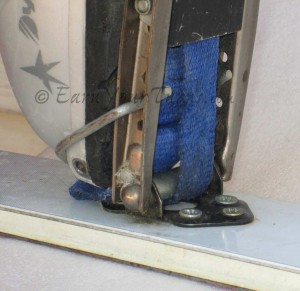
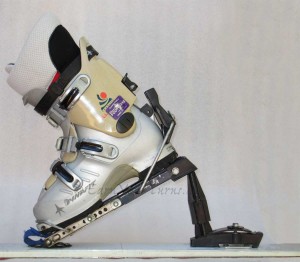
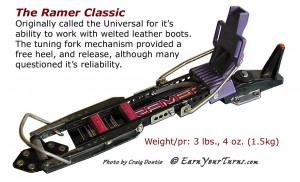
3 comments
1 ping
That binding, I suspect, is the reason I and many others tele. Crossed the Chugach once with Ramers and then again with leathers and have been saving my knees ever since.
You may not have liked the binding much, but I know you loved the climbing peg funcion.
I have 2 pair of ramer bindings, mounted to skis, that I would like to find a good home for. $50 each, complete and good condition andycberger@aol.com, vail, co
970-390-0855
[…] The original Alpine touring binding: The ramer […]